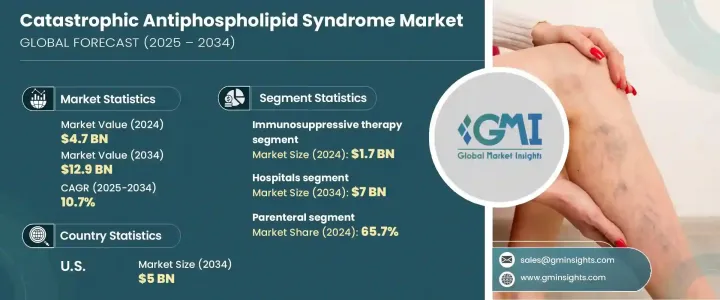
|
시장보고서
상품코드
1698308
파국적 항인지질 항체 증후군 시장 기회, 성장 촉진요인, 산업 동향 분석, 예측(2025-2034년)Catastrophic Antiphospholipid Syndrome Market Opportunity, Growth Drivers, Industry Trend Analysis, and Forecast 2025-2034 |
||||||
세계의 파국적 항인지질 항체 증후군 시장은 2024년 47억 달러로 평가되었으며, 2025년부터 2034년까지 연평균 복합 성장률(CAGR) 10.7%를 나타낼 것으로 예측됩니다.
이 시장을 견인하고 있는 것은 자가면역질환의 유병률의 상승과, 항인지질 증후군(APS)의 생명을 위협하는 변종인 파국적 항인지질 항체 증후군(CAPS)에 대한 인식의 높아입니다. 진단 기술의 진보에 의해 질환의 조기 발견이 가능하게 되어, 효과적인 치료에 수요가 높아지고 있습니다.

CAPS는 어셔슨 증후군이라고도 불리며, 다장기에 영향을 미치는 급속한 혈전 현상을 특징으로 하는 심각한 자가면역 질환입니다.
| 시장 범위 | |
|---|---|
| 시작 연도 | 2024년 |
| 예측 연도 | 2025-2034년 |
| 시작 금액 | 47억 달러 |
| 예측 금액 | 129억 달러 |
| CAGR | 10.7% |
치료 중 면역 억제 요법은 여전히 지배적인 부문이며 2022년에는 14억 달러, 2024년에는 17억 달러에 달했습니다. 또한, 면역억제요법의 효능을 뒷받침하는 임상 증거 증가가 시장 수요를 뒷받침하고 있습니다.
시장은 추가 투여 경로에 따라 분류되며, 비경구 치료가 선도하고 2024년 시장 점유율의 65.7%를 차지했습니다. 이 부문은 예측 기간 동안 10.6%의 연평균 성장률(CAGR)로 성장할 것으로 예상됩니다. CAPS의 중증도는 즉각적인 의료 개입을 필요로 하기 때문에 치료 효과의 속도로부터 비경구 투여가 바람직한 선택지가 되고 있습니다.
최종 용도별로 병원이 가장 큰 부문을 차지하고 있으며 2034년까지 70억 달러에 달하며 CAGR 10.5%를 나타낼 것으로 예측됩니다. 또한 병원은 제약회사나 연구기관과 자주 연계하여 임상시험을 촉진하여 환자에게 진보적인 치료법을 제공합니다.
미국 시장에서도 2024년에는 19억 달러의 매출이 있었으며, 2034년에는 50억 달러에 이를 것으로 예상되고 있습니다.
목차
제1장 조사 방법과 조사 범위
제2장 주요 요약
제3장 업계 인사이트
- 생태계 분석
- 업계에 미치는 영향요인
- 성장 촉진요인
- 자가면역질환의 유병률 증가
- 진단제 및 치료제의 기술적 진보
- 파국적 항인지질 항체 증후군(CAPS)에 대한 인식 증가
- 헬스케어 지출 증가
- 업계의 잠재적 위험 및 과제
- 고액의 치료비
- 한정된 전문적 치료
- 성장 촉진요인
- 성장 가능성 분석
- 규제 상황
- 향후 시장 동향
- Porter's Five Forces 분석
- PESTEL 분석
제4장 경쟁 구도
- 서론
- 기업 매트릭스 분석
- 기업 점유율 분석
- 주요 시장 기업의 경쟁 분석
- 경쟁 포지셔닝 매트릭스
- 전략 대시보드
제5장 시장 추계·예측 : 치료별(2021-2034년)
- 주요 동향
- 항응고제
- 면역억제요법
- 혈장 교환 요법
- 정맥 내 면역 글로불린(IVIG)
- 기타 치료
제6장 시장 추계·예측 : 투여 경로별(2021-2034년)
- 주요 동향
- 경구
- 비경구
제7장 별시장 추계·예측 : 최종 용도별(2021-2034년)
- 주요 동향
- 병원
- 전문 클리닉
- 외래수술센터(ASC)
- 기타 최종 사용
제8장 시장 추계·예측 : 지역별(2021-2034년)
- 주요 동향
- 북미
- 미국
- 캐나다
- 유럽
- 독일
- 영국
- 프랑스
- 스페인
- 이탈리아
- 네덜란드
- 아시아태평양
- 중국
- 인도
- 일본
- 호주
- 한국
- 라틴아메리카
- 브라질
- 멕시코
- 아르헨티나
- 중동 및 아프리카
- 남아프리카
- 사우디아라비아
- 아랍에미리트(UAE)
제9장 기업 프로파일
- Abbott Laboratories
- AbbVie
- Boehringer Ingelheim International
- Bristol Myers Squibb Company
- Cadrenal Therapeutics
- Eli Lily and Company
- F. Hoffmann-La Roche
- Johnson &Johnson Services
- Merck
- Novartis
- Pfizer
- Sanofi
The Global Catastrophic Antiphospholipid Syndrome Market was valued at USD 4.7 billion in 2024 and is expected to grow at a CAGR of 10.7% from 2025 to 2034. The market is driven by the rising prevalence of autoimmune disorders and growing awareness of CAPS, a life-threatening variant of antiphospholipid syndrome (APS). Technological advancements in diagnostics are enhancing early disease detection, increasing demand for effective treatments. Government and private sector research funding are further accelerating the development of novel therapies.

CAPS, also known as Asherson's syndrome, is a severe autoimmune disorder characterized by rapid thrombotic events affecting multiple organs. Due to the complexity of this condition, treatment approaches vary and typically include anticoagulation, corticosteroids, plasma exchange, and other immunosuppressive therapies. The market is segmented by treatment type, route of administration, and end-use settings.
| Market Scope | |
|---|---|
| Start Year | 2024 |
| Forecast Year | 2025-2034 |
| Start Value | $4.7 Billion |
| Forecast Value | $12.9 Billion |
| CAGR | 10.7% |
Among treatments, immunosuppressive therapy remains the dominant segment, valued at USD 1.4 billion in 2022 and projected to reach USD 1.7 billion in 2024. These drugs, often combined with anticoagulants and corticosteroids, are vital for improving patient outcomes. Increasing clinical evidence supporting the efficacy of immunosuppressive therapy is bolstering market demand. Additionally, orphan drug designations by regulatory bodies such as the U.S. FDA and EMA are promoting the adoption of immunosuppressive treatments, including cyclophosphamide, rituximab, and corticosteroids.
The market is further categorized based on the route of administration, with parenteral treatments leading, accounting for 65.7% of the market share in 2024. This segment is expected to grow at a CAGR of 10.6% through the forecast period. The severity of CAPS necessitates immediate medical intervention, making parenteral administration the preferred choice due to its rapid therapeutic effects. The rising use of biologic therapies such as rituximab and eculizumab via parenteral delivery is further strengthening market growth. Innovations in drug delivery systems, including infusion pumps and prefilled syringes, are enhancing treatment efficacy and expanding adoption.
In terms of end-use, hospitals represent the largest segment, projected to reach USD 7 billion by 2034, growing at a CAGR of 10.5%. Hospitals are equipped with advanced diagnostic and treatment facilities, making them the primary centers for CAPS management. Rising healthcare expenditures and improved hospital infrastructure are driving this segment's growth. Additionally, hospitals frequently collaborate with pharmaceutical companies and research organizations to facilitate clinical trials, bringing advanced therapies to patients. The increasing presence of specialized rheumatologists in hospital settings is further contributing to the expanding market.
The U.S. market alone generated USD 1.9 billion in 2024 and is expected to reach USD 5 billion by 2034. The growing number of autoimmune disease cases in the country is fueling demand for better treatment options. Increased investment in research and the adoption of modern diagnostic systems are accelerating market expansion. The rising use of anticoagulants such as warfarin and heparin among healthcare professionals is also supporting market growth.
Table of Contents
Chapter 1 Methodology and Scope
- 1.1 Market scope and definition
- 1.2 Research design
- 1.2.1 Research approach
- 1.2.2 Data collection methods
- 1.3 Base estimates and calculations
- 1.3.1 Base year calculation
- 1.3.2 Key trends for market estimation
- 1.4 Forecast model
- 1.5 Primary research and validation
- 1.5.1 Primary sources
- 1.5.2 Data mining sources
Chapter 2 Executive Summary
- 2.1 Industry 3600 synopsis
Chapter 3 Industry Insights
- 3.1 Industry ecosystem analysis
- 3.2 Industry impact forces
- 3.2.1 Growth drivers
- 3.2.1.1 Increasing prevalence of autoimmune disorders
- 3.2.1.2 Technological advancements in diagnostics and therapeutics
- 3.2.1.3 Rising awareness of catastrophic antiphospholipid syndrome (CAPS)
- 3.2.1.4 Increasing healthcare expenditure
- 3.2.2 Industry pitfalls and challenges
- 3.2.2.1 High treatment costs
- 3.2.2.2 Limited availability of specialized treatment
- 3.2.1 Growth drivers
- 3.3 Growth potential analysis
- 3.4 Regulatory landscape
- 3.5 Future market trends
- 3.6 Porter’s analysis
- 3.7 PESTEL analysis
Chapter 4 Competitive Landscape, 2024
- 4.1 Introduction
- 4.2 Company matrix analysis
- 4.3 Company market share analysis
- 4.4 Competitive analysis of major market players
- 4.5 Competitive positioning matrix
- 4.6 Strategy dashboard
Chapter 5 Market Estimates and Forecast, By Treatment, 2021 – 2034 ($ Mn)
- 5.1 Key trends
- 5.2 Anticoagulants
- 5.3 Immunosuppressive therapy
- 5.4 Plasma exchange therapy
- 5.5 Intravenous immunoglobulin (IVIG)
- 5.6 Other treatments
Chapter 6 Market Estimates and Forecast, By Route of Administration, 2021 – 2034 ($ Mn)
- 6.1 Key trends
- 6.2 Oral
- 6.3 Parenteral
Chapter 7 Market Estimates and Forecast, By End Use, 2021 – 2034 ($ Mn)
- 7.1 Key trends
- 7.2 Hospitals
- 7.3 Specialty clinics
- 7.4 Ambulatory surgical centers
- 7.5 Other end use
Chapter 8 Market Estimates and Forecast, By Region, 2021 – 2034 ($ Mn)
- 8.1 Key trends
- 8.2 North America
- 8.2.1 U.S.
- 8.2.2 Canada
- 8.3 Europe
- 8.3.1 Germany
- 8.3.2 UK
- 8.3.3 France
- 8.3.4 Spain
- 8.3.5 Italy
- 8.3.6 Netherlands
- 8.4 Asia Pacific
- 8.4.1 China
- 8.4.2 India
- 8.4.3 Japan
- 8.4.4 Australia
- 8.4.5 South Korea
- 8.5 Latin America
- 8.5.1 Brazil
- 8.5.2 Mexico
- 8.5.3 Argentina
- 8.6 Middle East and Africa
- 8.6.1 South Africa
- 8.6.2 Saudi Arabia
- 8.6.3 UAE
Chapter 9 Company Profiles
- 9.1 Abbott Laboratories
- 9.2 AbbVie
- 9.3 Boehringer Ingelheim International
- 9.4 Bristol Myers Squibb Company
- 9.5 Cadrenal Therapeutics
- 9.6 Eli Lily and Company
- 9.7 F. Hoffmann-La Roche
- 9.8 Johnson & Johnson Services
- 9.9 Merck
- 9.10 Novartis
- 9.11 Pfizer
- 9.12 Sanofi



















